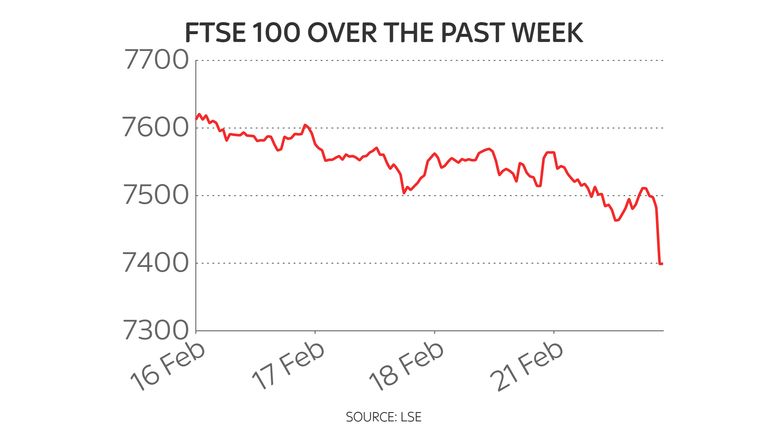Oil marches towards $100 a barrel as markets react to Ukraine developments
Stock markets have plunged and Brent crude oil and natural gas costs have surged as the crisis over Ukraine deteriorates.
Brent, the international oil benchmark, was trading just above $99 at one stage on Tuesday – its highest level since the summer of 2014 – and market experts warned of an inevitable spike beyond $100 in the event of a full invasion of Ukraine by Russia.
The price climbed by more than 4% as tanks and armoured personnel carriers were seen on the outskirts of Donetsk, the capital of one of two breakaway regions of eastern Ukraine that Russia said it had now recognised as republics.
US and European sanctions are to follow president Putin’s declaration – raising the stakes – and the lack of clarity over the full extent of those financial punishments, and Russia’s reaction to them, drove volatility across market values globally.
The UK said it was going to target five banks and three wealthy individuals initially while Germany said it had halted approval of the controversial Nord Stream 2 gas pipeline from Russia.
President Putin could potentially respond by disrupting supplies of Russian oil and gas to Europe, threatening to add to an energy-led inflation spiral on the continent.
Market commentators warned that any move towards military conflict would tip raw energy prices up sharply because of Russia’s hold over European supplies.
UK contracts for next-day natural gas delivery were up by more than 7% on Tuesday but, at 183p-per-therm, the cost is well down on levels above 400p seen last year.
However, contracts for future delivery saw a larger spike, of almost 11%, reflecting the heightened uncertainty.
Europe currently relies on Russia for more than 40% of its natural gas – with costs already reeling from weak stocks and supply disruption that have pushed UK energy bills to record levels, with the promise of worse to come in April and beyond already.
Stock markets in Asia were the first to react to the uncertainty created by Russia’s strategic move on Ukraine.
The Hang Seng in Hong Kong was down by almost 3% while Japan’s Nikkei shed just shy of 2%.
In London, the FTSE 100 opened 1.5% down led by banking and travel-related stocks. The DAX in Frankfurt was 2.5% off in early trading.
However, values later crept into positive territory as investors took some heart from Kremlin assurances that it was still open to diplomacy while safer commodity-linked shares came into sharper focus at the expense of riskier assets.
US futures, which had showed the S&P 500 and Nasdaq to fall sharply, also recovered some ground as the implications of the Russian action evolved amid no sign of an imminent
Russia’s rouble-linked stock market, the MOEX, was 7% down – building on sharp losses witnessed on Monday – but also saw an improvement in afternoon trading in Moscow.
Ipek Ozkardeskaya, senior analyst at Swissquote, wrote: “The latest turn of events narrows the chances of a Russian pullback, and the window for diplomacy is almost shut.
“The US ordered new sanctions on Russia and the new Russian-backed republics; Europeans pledged to respond as well. This is the worst escalation since the Cold War.”
She added: “The risk off mode will likely stay on for the coming hours, but at this point it’s hard to predict what’s next.
“Any positive news could reverse the bearish action and lead to sudden jumps in risk asset prices, yet a further escalation of tensions, which now became the base case scenario, should further enhance gains in energy, safe haven assets and gold.”





